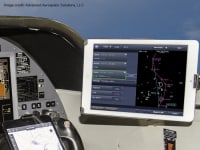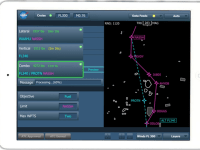

NASA Langley is developing Traffic Aware Strategic Aircrew Requests (TASAR). TASAR features a cockpit automation system that monitors for potential flight trajectory improvements and displays them to the pilot. These wind-optimized flight trajectory changes are pre-cleared of potential conflicts with other known airplane traffic, weather hazards, and airspace restrictions. The objective of TASAR is to improve the process in which pilots request flight path and altitude modifications due to changing flight conditions. Changes may be made to reduce flight time, increase fuel efficiency, or improve some other flight attribute desired by the operator. Currently pilots make such requests to ATC with limited awareness of what is happening around them. Consequently, some of these requests will be denied resulting in no flight improvements and an unnecessary workload increase for both pilots and ATC. The TASAR technology provides pilots with recommended flight path and altitude improvements that are more likely to be approved by ATC.
Benefits
•Saves fuel and reduces flight time
•Flight plan requests to ATC more likely to be approved
•Minimal implementation cost
•Benefits accrue from first flight of every equipped aircraft
Applications
•Flight optimization for commercial and general aviation
•Incentive for ADS-B IN equipage
The Technology
Example of using TAP to save fuel and flight time while avoiding traffic and weather, and restricted airspace. Image credit: NASA
The NASA software application developed under the TASAR project is called the Traffic Aware Planner (TAP). TAP automatically monitors for flight optimization opportunities in the form of lateral and/or vertical trajectory changes. Surveillance data of nearby aircraft, using ADS-B IN technology, are processed to evaluate and avoid possible conflicts resulting from requested changes in the trajectory. TAP also leverages real-time connectivity to external information sources, if available, of operational data relating to winds, weather, restricted airspace, etc., to produce the most acceptable and beneficial trajectory-change solutions available at the time. The software application is designed for installation on low-cost Electronic Flight Bags that provide read-only access to avionics data. The user interface is also compatible with the popular iPad. FAA certification and operational approval requirements are expected to be minimal for this non-safety-critical flight-efficiency application, reducing implementation cost and accelerating adoption by the airspace user community.
Awarded "2016 NASA Software of the Year"
-
Awards
-
 2018 Sustainable Technologies Honorable Mention
2018 Sustainable Technologies Honorable Mention -
 2018 Top 100 Entries
2018 Top 100 Entries
Like this entry?
-
About the Entrant
- Name:Kimberly Middleton
- Type of entry:teamTeam members:Mark G. Ballin
David J. Wing - Patent status:patented





